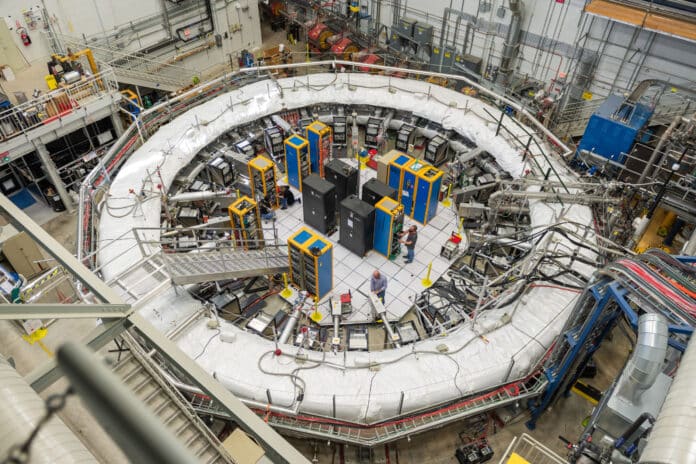Muons are fundamental particles with a tiny internal magnet that processes or wobbles like the axis of a spinning top in the presence of a magnetic field. The muon magnetic moment, commonly denoted by the letter g, affects the precession speed in a specific magnetic field; at its most basic level, theory suggests that g should equal 2.
An international collaboration of scientists working on the Muon g-2 experiment at the U.S. Department of Energy’s Fermi National Accelerator Laboratory announced a brand-new measurement of muon’s anomalous magnetic moment. This new measurement improves the precision of their previous result by a factor of 2.
This new value bolsters the first result they announced in April 2021. That result suggested that muons behave in a way not predicted by the Standard Model of particle physics.
Brendan Casey, a senior scientist at Fermilab who has worked on the Muon g-2 experiment since 2008, said, “We’re probing new territory. We’re determining the muon magnetic moment more precisely than ever.”
The interactions of the muon with particles in a quantum foam surrounding it cause the difference of g from 2 — or g minus 2 — to exist. Like subatomic “dance partners,” these particles appear and disappear briefly before grabbing the muon’s “hand” and changing how it interacts with the magnetic field. The Standard Model predicts how the quantum foam changes g and includes all known “dance partner” particles. However, there could be more. The possibility of as-yet-undiscovered particles contributing to the value of g-2 and opening the door to new physics research excites physicists.
The new experimental result, based on the first three years of data, announced by the Muon g-2 collaboration is:
g-2 = 0.00233184110 +/- 0.00000000043 (stat.) +/- 0.00000000019 (syst.)
The measurement of g-2 corresponds to a precision of 0.20 parts per million.
Peter Winter, co-spokesperson for the Muon g-2 collaboration, said, “This measurement is an incredible experimental achievement. Getting the systematic uncertainty down to this level is a big deal and is something we didn’t expect to achieve so soon.”
The Muon g-2 collaboration shot a beam of muons into a 50-foot-diameter superconducting magnetic storage ring periodically to make the measurement, where they circulated 1,000 times at almost the speed of light. The speed at which the muons were processing was measured by detectors lining the ring. To calculate the value of g-2, physicists must first properly measure the magnetic field’s strength.
Graziano Venanzoni, professor at the University of Liverpool affiliated with the Italian National Institute for Nuclear Physics, Pisa, said, “Our new measurement is fascinating because it takes us well beyond Brookhaven’s sensitivity.”
The Muon g-2 collaboration describes the result in a paper that they submitted today to Physical Review Letters.
